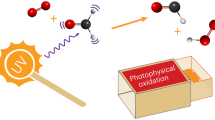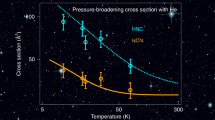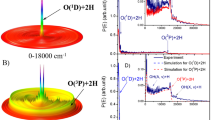Abstract
CONCERN about the depletion of stratospheric ozone by nitrogen oxides released by high flying aircraft1 and by chlorine species from the decomposition of halocarbons2,3 has emphasised the need for laboratory data on the elementary reaction steps involved, particularly those which control the concentration of the hydroxyl radical (HO) in the stratosphere. HO has an important role in both ozone destruction mechanisms, since it combines with NO2 to form the relatively inert HNO3 molecule and converts the inactive HCl formed from Cl + CH4 back into active Cl atoms. In the stratosphere the ‘odd hydrogen’ species H, HO, and HO2 are formed by the reactions of O(1D) with H2O, H2 and CH4 and by the photolysis of H2O, processes which are comparatively well understood. The odd hydrogen species are interconverted largely by reactions such as HO + O3 → HO2 + O2 (1) O + HO → O2 + H (2) H + O2 + M → HO2 + M (3) O + HO2 → HO + O2 (4) and removed mainly by HO + HO2 → H2O + O2 (5) The rate coefficients for reactions (1) to (3) are relatively well established4–6 but there is no previous experimental determination of k4 and measurements of k5 (which have not been based on direct and unequivocal measurements of the concentration of HO2) have yielded values between 2 × 10−11 and 2 × 10−10 cm3 molecule−1 s−1 (refs 7–9). We report the first direct measurements of the rate coefficients k4 and k5 for which we have used the novel technique of laser magnetic resonance.
This is a preview of subscription content, access via your institution
Access options
Subscribe to this journal
Receive 51 print issues and online access
$199.00 per year
only $3.90 per issue
Buy this article
- Purchase on Springer Link
- Instant access to full article PDF
Prices may be subject to local taxes which are calculated during checkout
Similar content being viewed by others
References
Johnston, H. S. Science 173, 517 (1971).
Molina, M. J. & Rowland, F. S. Nature 249, 810 (1974).
Nat. Acad. Sci. Rep. Halocarbons—Effects on Stratospheric Ozone (Washington DC, 1976).
Anderson, J. G. & Kaufman, F. Chem. Phys. Lett. 19, 483 (1973).
Hampson, R. F. & Garvin, D. (eds) N.B.S. Technical Note 866, (Washington DC, 1975).
Clyne, M. A. A. & Thrush, B. A. Proc. R. Soc. A275, 559 (1963).
Johnston, H. S. & Paukert, T. T. J. chem. Phys. 56, 2824 (1972).
Hochanadel, C. J., Ghormley, J. A. & Ogren, P. J. J. chem. Phys. 56, 4426 (1972).
Friswell, N. J. & Sutton, M. M. Chem. Phys. Lett. 15, 108 (1972).
Hougen, J. T. J. molec. Spec. 54, 447 (1975).
Dieke, G. H. & Crosswhite, H. M. J. quant. Spec. Rad. Transfer 2, 97 (1962).
Carsky, P., Machacek, M. & Zahradnik, R. Collect. Czech Chem. Commun. 38, 3067 (1973).
Powell, F. X. & Lide, D. R. J. chem. Phys. 42, 4201 (1965).
Hamilton, E. J., J. chem. Phys. 63, 3682 (1975).
Hack, W., Hoyermann, K. & Wagner, H. G. Int. J. Chem. Kin. Symp. 1, 329 (1975).
Author information
Authors and Affiliations
Rights and permissions
About this article
Cite this article
BURROWS, J., HARRIS, G. & THRUSH, B. Rates of reaction of HO2 with HO and O studied by laser magnetic resonance. Nature 267, 233–234 (1977). https://doi.org/10.1038/267233a0
Received:
Accepted:
Issue Date:
DOI: https://doi.org/10.1038/267233a0
This article is cited by
-
On the validation of one-dimensional CFC–ozone depletion models
Nature (1981)
-
A calculation of the possible depletion of ozone by chlorofluorocarbons using a two-dimensional model
Pure and Applied Geophysics PAGEOPH (1980)
-
Increased atmospheric carbon dioxide and stratospheric ozone
Nature (1978)
-
The effect of the HO2+NO reaction rate constant on one-dimensional model calculations of stratospheric ozone perturbations
Pure and Applied Geophysics PAGEOPH (1978)
Comments
By submitting a comment you agree to abide by our Terms and Community Guidelines. If you find something abusive or that does not comply with our terms or guidelines please flag it as inappropriate.



